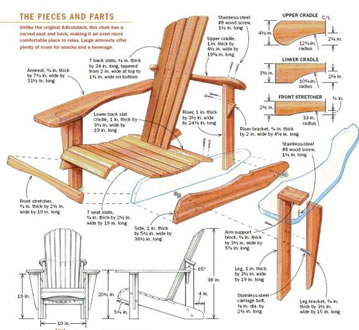Router bits come in all shapes and sizes. Depending on what kind of woodworking you like to do, you may need 10 bits or 100 making it a complete router bit set.
If you’re just getting started in woodworking and don’t know what bits to get, don’t worry; you’ll find all the information you need in this article. A few basic bits can do a lot, and you can always add to your collection when you take on a project that requires something you don’t already have.
Best Router Bit Sets
A good starter set will have a combination of bits for decorative profiles, joinery, rabbeting and flush trimming. Here are a few good options for the beginning woodworker.
1. Yonico 17702 70 Bit Professional Router Bit Set
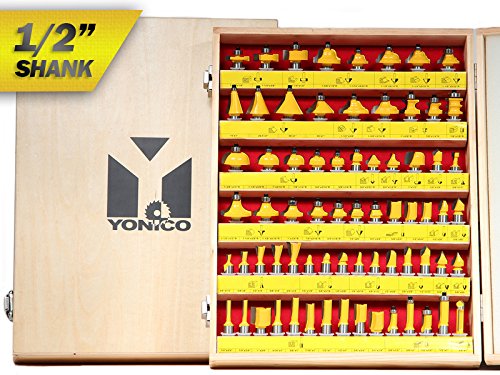
This set includes several sizes of the round over, chamfer, ogee, bullnose, cove, straight, dovetail v groove, and flush-trimming bits. You should be able to handle any profile and joint making task with this set, other than door making. Yonico bits are made with high-grade carbide and designed to provide professional results within the hobbyist’s budget.
2. MLCS 8369 ½” Shank, 30 Piece Router Bit Set

You’ll get several straight, dovetail, chamfer, core box, ogee, rabbet, cove and roundover bits with this set. All bits in this set come with ½” shanks.
3. Yonico 12335 Raised Panel Cabinet Door Router Bit Set with Ogee Profile

Make your own frame-and-panel doors with this 3-piece set that includes a panel-raising bit. It’s the perfect complement to one of the general-purpose sets above and will allow you to make almost any furniture or cabinet project you can dream up.
4. Freud 97-150 3 Piece Door Router Bit Set
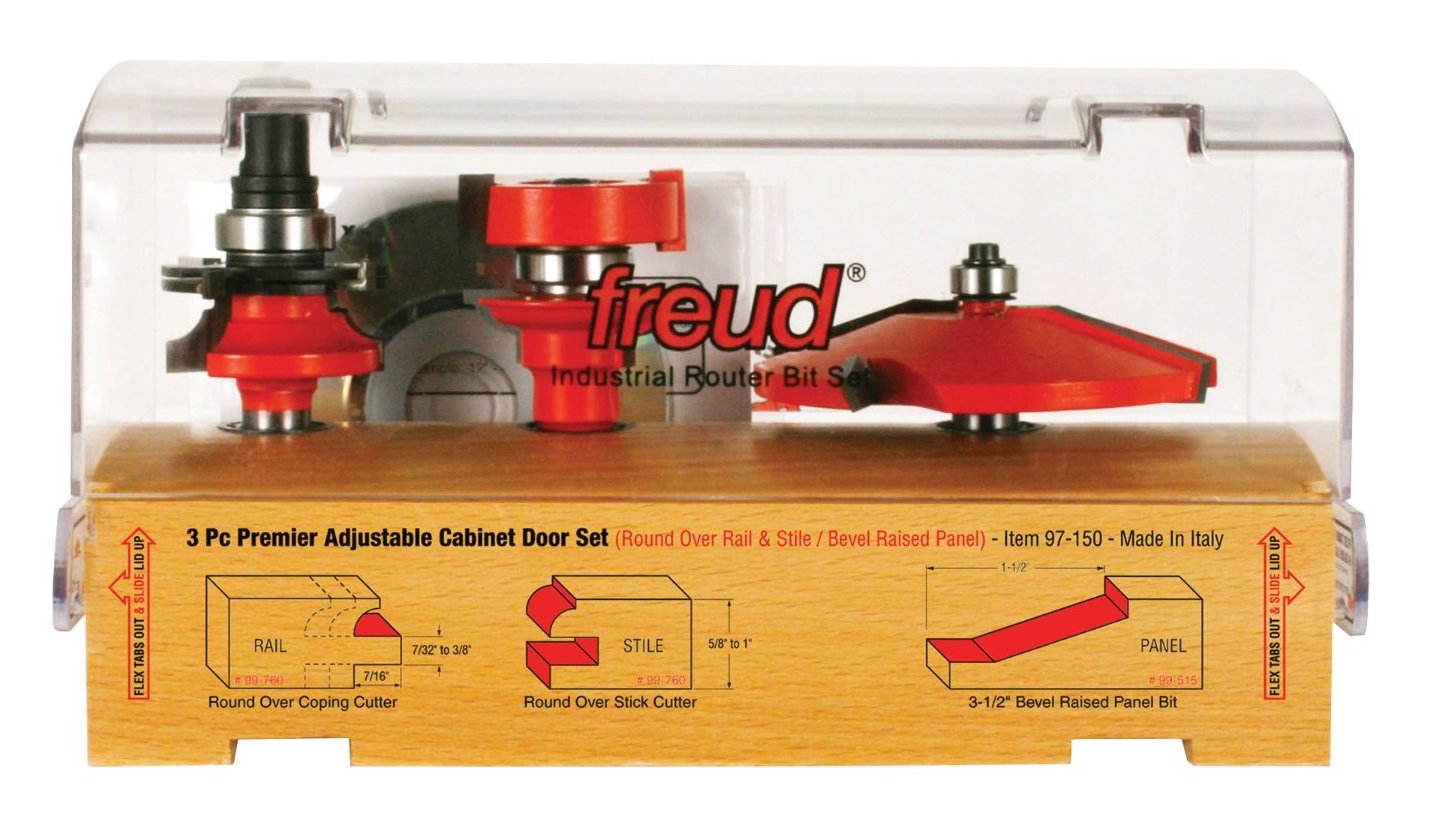
Freud bits are known to be top quality, and this is an excellent set of the door making bits you can use to make doors from 5/8” to 1-1/4” thick. The included panel-raising bit produces a beveled panel, and the door profile is a simple bead.
5. Yonico 15336 Jointing Router Bit Set, 3 Piece
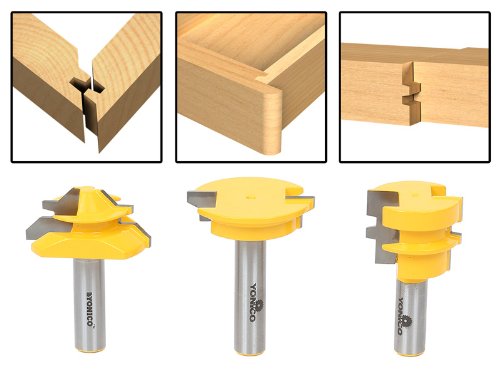
You can make lock miters, drawer front joints and glue joints with this set. That’s all the joinery you need for projects like small boxes, furniture legs, drawers, and tabletops. If you own this set, plus a door making and a general-purpose set like the first two in this list, there’s nothing you can’t do.
Router Bits for Decorative Profiles
Ogee
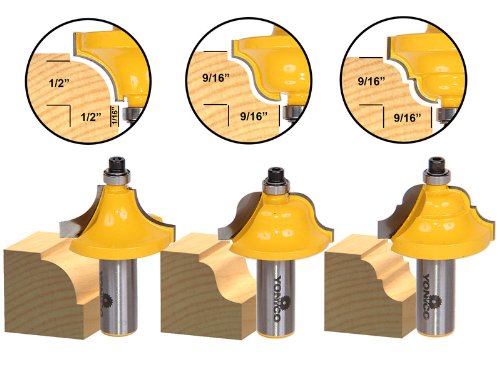
To make decorative edges indoors and drawer fronts, you need a router and the appropriate bit. There are plenty of fancy profile bits on the market, but only a few that most woodworkers would consider essential. The ogee is one of the most common profiles for doors and drawer fronts, and there are a few variations of it. You’ll see the ogee in all kinds of cabinet and furniture projects, and there probably isn’t a cabinet shop in the world that doesn’t have at least one of these bits.
A good bit should be fitted with a bearing at the end of the shank so that you can use it for handheld operations and in your router table. For under $25, you should be able to find a set of the three most popular ogee bits: the round over bead, the classical ogee, and the double roman ogee.
Table Edge Profiles
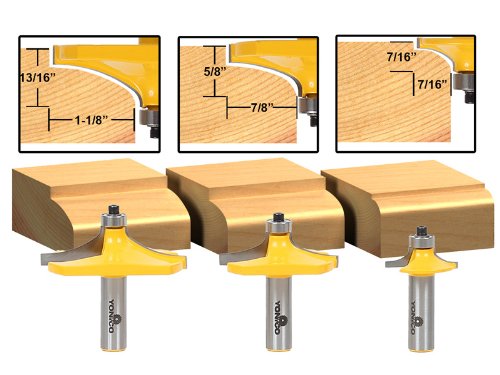
Table edges can be plain and square or highly ornate. A Shaker table should have simple edges that are slightly eased, but to give your own designs a little more flare, consider investing in a set of table edge bits.
A three-piece table edge router bit set should set you back about $45 and will provide a number of options for decorative edges in all kinds of tables. There are more expensive sets available from different manufacturers, but you don’t need to spend a small fortune for premium bits unless you plan to build tables by the dozen.
Bullnose Bits
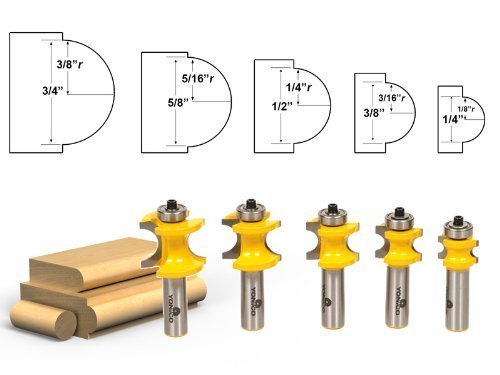
Frequently, one little detail can really make a project stand out. A bullnose edge on a shelf is a perfect example, and you’ll find a good set of 5 bullnose bits online for materials between ¼” and ¾” thick for about $40. A bullnose also makes a nice table or countertop edge, and it’s a good idea to have one large bit (maybe 1-1/4”) on hand for special projects.
Roundovers
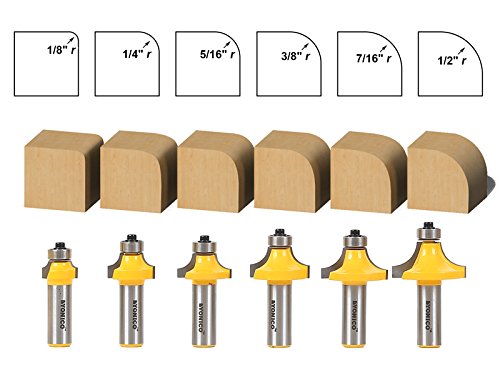
The roundover could be the most commonly used profile in woodworking. You’ll find it on face frames for cabinets and furniture, and you’ve surely seen it many times on the edges of legs and furniture components. A roundover gives a project a finished look and softens sharp edges.
Many woodworkers have a roundover bit permanently set up in a palm router for convenience. Because you’ll probably find yourself using this bit often, you might want to do the same. Roundovers come in a variety of sizes, but a 1/8” bit is a must. Other sizes are also helpful, like ¼”, 3/8” and ½”. You can get six popular sizes in one set for about $40, and it’s safe to say you’ll use them all.
Chamfer Bits
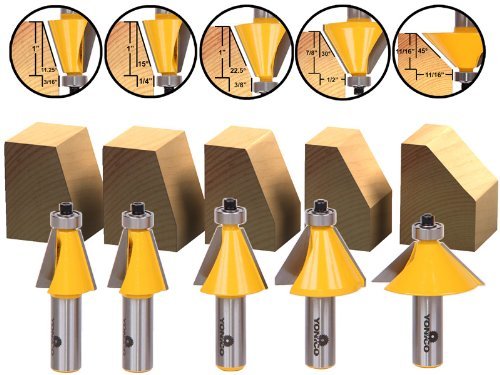
Next to the roundover, the chamfer might be the second most popular bit for simple edge details in a cabinet and furniture projects. A chamfer is a simple angle, usually 45 degrees, cut into the edge of a piece. For a factory-made look, you can route a 1/16” to 1/8” chamfer in the edges of your furniture. A bigger chamfer (3/8”) looks nice in a face frame for an entertainment center or armoire. You’ll get a lot of use out of a basic collection of chamfer bits with angles between 11.25 degrees and 45 degrees.
Cove Bits
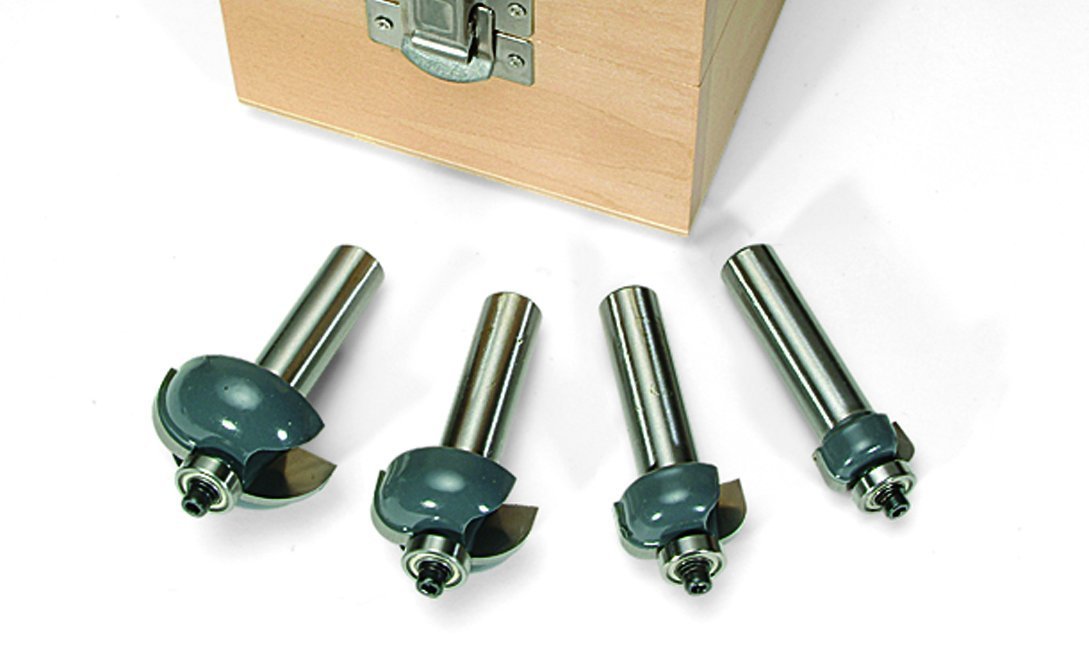
A roundover bit produces a convex profile on the edge of a board, but a cove does the opposite. Coves, or concave profiles, are often routed into the edges of doors, drawer fronts, and face frames. Just like roundover bits, cove bits come in a variety of sizes, starting around 1/8”. A good set of three or four bits up to ½” should take care of all your cove routing needs.
Router Bits for Joinery
Joinery is the heart of woodworking, and a router is a perfect tool for making all kinds of joints. From dovetails to lap joints, the router can do it all, if you have the right bits. A half dozen bits should be all you need to make just about any joint.
Straight Bit
A straight bit is about as simple as a router bit can be. It usually has two straight cutting edges and is excellent for all kinds of joinery work. In a portable router, you can use a straight bit and jig to produce rabbets, lap joints, tenons, mortises, dados, box joints and more.
When set in the router table, the straight bit can even function as a jointer to straighten the edges of crooked boards. No bit is quite as versatile as this one, so it’s a must-have. You’ll want a few different sizes, from ¼” diameter up to at least ½”. For lap joints and work that requires the removal of large amounts of material, go even bigger (think ¾”). There are myriad jigs and accessories that will help you get more out of your straight bits.
Dovetail Bits

What woodworker doesn’t love a good dovetail joint? It’s an attractive way to join parts for cabinets, furniture, and drawers. Dovetails can be any width, but are often ½” in drawer parts and wider in cabinet components. The angle on a dovetail bit can vary, but 14 degrees is common. You can use a dovetail bit with a special jig to make dovetailing easy, and you can find several different jigs for this purpose. It’s good to have a few different diameters and angles, so look for a set that has a few bits and experiment to find the bit you’ll end up using most.
Glue Joint Bit
When you need to glue up solid wood to make panels for doors or tabletops, a glue joint bit will make the job much easier. It can be difficult to keep boards aligned during glue-up, so woodworkers often use dowels or biscuits in their panels. That can sometimes be a problem, and the glue joint bit eliminates the need for fasteners of any kind.
Glue joint bits work this way: You route the edge of one board with the top face down on the router table and then route the edge of the mating board with the top face up. When you butt the edges of the two boards together, they fit into each other. Glue joint bits produce self-aligning joints, which make panel glue-ups a breeze. For most projects, you’ll need a bit that works with the stock up to ¾” or thicker.
Lock Miter Bits
To build small boxes, furniture legs or columns with solid wood, nothing compares to the lock miter bit. It produces interlocking parts with plenty of glue surface. This bit can be tricky to set up, and you’ll have to route half of your parts on edge, but once you get the hang of how a lock miter bit works, you’ll use it often.
Several manufacturers make lock miter bits, but they all function the same way. A few companies sell setup block with their bits, which make a much easier job of getting things right the first time. Almost all lock miter bits will handle material up to ¾” thick, and you should get one with a ½” shank.
Rabbeting Miter Bit
Lock miter joints are strong in solid stock, but they don’t work as well in plywood or MDF. The little fingers on the joint tend to break in these materials, so a rabbet miter joint is a better choice. A rabbet miter joint is probably just what you think it is, a miter joint with a rabbet.
Unlike the lock miter, you’ll need two bits to produce this joint, and they’re usually sold together. You install the smaller bit in your router table and route half of your stock. Then, you install the larger bit and route the second half. The result is a self-aligning joint with a lot of glue surface. Look for a rabbeting miter joint bit set that includes a setup block; the setup can be fussy.
Bits for Door Making
Door Making Sets
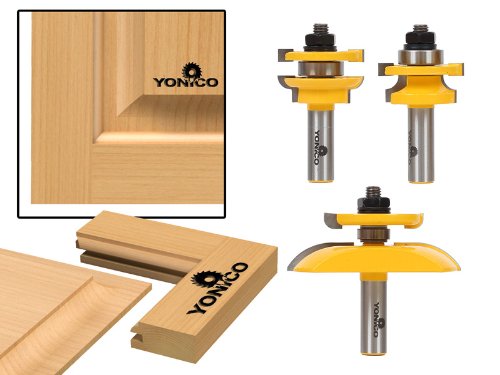
Do you want to make your own doors for cabinets and furniture? It’s easy to with a router and a few bits. You can buy a complete set that includes bits for the coping cut, profile and raised panel.
To make doors on the router, you route the ends of the rails with one bit and then route the profile on the inside edge of the rails and stiles with another bit. To route the panel, you use a third bit. Door making router bit sets are available with a variety of profiles, including all kinds of ogees. An inexpensive three-piece set starts around $55, but there are so many options and you can easily spend upwards of $200 for premium bits.
Router bit manufacturers now offer “stacked” rail and stile bits that can make cope and profile cuts, so you only need one bit instead of two. There are inexpensive stacked bits for about $25 online, but high-quality bits can be over $100. When you get one of these bits, remember that you’ll still need the panel-raising bit.

Handy Bits for Other Work
Rabbeting Bit

A rabbet is essentially a small step in the edge of a board, and it’s a detail that most woodworkers need to create from time to time. You can buy rabbeting bits in different diameters, or purchase one bit with a number of bearings that will allow you to make rabbets in several sizes with the same cutter. A decent rabbeting bit will make rabbets up to ½” wide.
Flush Trimming Bit

After the straight bit, the flush trimming bit has to be the most useful bit you’ll ever own. It allows you to trim a piece of wood flush with another and is great for template routing. You can route exact copies of a template with a flush trimming bit.
Cabinetmakers use these bits to trim the overhang on face frames flush with cabinet end panels. You should have these bits with ¼” and ½” shanks with matching cutter diameters for maximum flexibility.
V Groove Bit
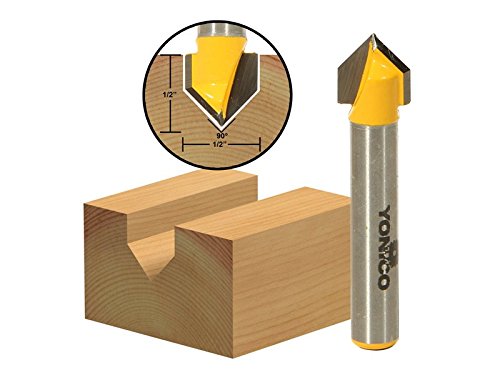
You can make your own signs with attractive lettering using a v groove bit, which has a cutter that comes to a sharp point at the tip. V groove bits are available with different cutter angles, and it’s helpful to have 45, 60 and 90-degree bits.
Core Box Bit
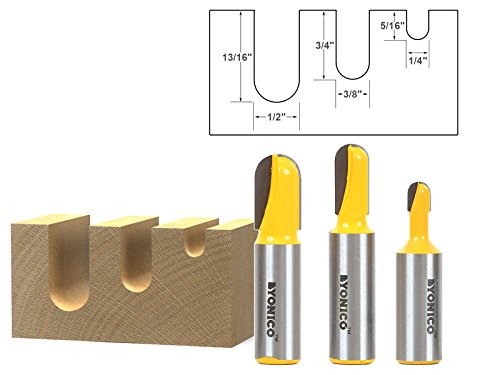
For 3D carving with a handheld router or a CNC machine, get yourself a core box bit. It’s a simple straight bit with a round end that can cut contours in the face of a board. A core box bit shouldn’t be used for plunge cuts; it’s meant to be ramped into the material.[no_toc]
